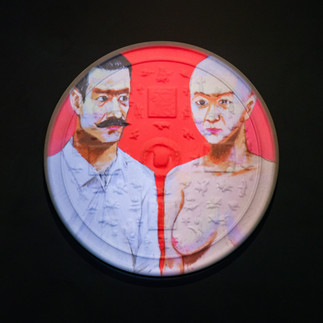Tender Comrade: an explicit exhibition for a censored topic
- Freya Parsons
- Oct 1
- 3 min read
Updated: Oct 14
Chippendale’s White Rabbit Gallery has never been shy about provocation, but with its latest exhibition Tender Comrade, the gallery has stepped into new territory: its first explicitly queer-themed show.
The result is raw, surprising, and in true White Rabbit fashion, impossible to walk away from without feeling a little undone. I talked to assistant curator (and very talented artist) Meng-Yu Yan about the collection.

Hand picked by David Williams, the exhibition draws from Judith Neilson’s collection of nearly 4,000 works. Ms Neilson is an Australian philanthropist who funds a range of projects, including the White Rabbit.
The art was picked using the lens of queerness itself. That means not just sexuality and gender identity, but what Meng-Yu calls "an attitude of resistance and a practice of subverting norms". The original meaning of ‘to queer something,’ they explained, is “about non-conformity, questioning, challenging, and transgressing.”
From the narrative to the name itself, Tender Comrade, is loaded with history.
In Chinese, the term tongzhi (comrade) was used as a standard Communist greeting. Its versatility allowed it to be easily picked up, and in 1989 at a gay and lesbian film festival in Hong Kong, the word was reclaimed. Since then, tongzhi has become shorthand for LGBTQIA+ in Chinese.

White Rabbit doesn’t do half-measures and as soon as you step inside, you’re greeted by a warning sign, a first for the gallery, hinting at the works’ explicitness. It also acts a teasing jab to those uncomfortable in queer spaces. "Do not enter if you're offended by nudity, love..."
Upstairs, Zheng Bo’s Pteridophilia series sets the tone. In the short film, sexuality is cut eco-activism. The graphic video challenges the usual concept of 'mother nature.'
"Humanity is then placed in this extractive, almost parasitic role. However, eco-sexuality challenges us to think of nature not as a “mother” but as a “lover” and consider how this relationship might be about both giving and receiving," Meng-Yu said.
Other works resonate with a quieter intimacy. Xia Han’s installations, which have never been seen in Sydney before, including Humiliation and the video Less is More, explore masculinity and online violence through gaming. He shows how avatars can both liberate and trap gender expression.

Ren Hang, whose stark photographs of naked bodies are cult objects among queer art-lovers, is also showcased. Meng-Yu said his work led to the emergence of si shying or ‘private photography’ which has influenced "an entire generation" of young Chinese photographic artists. One of these artists is Lin Zhipeng who
is also on display, with Layers being the cover art for Tender Comrade.
Queerness is more than sex, it is “community, connection, resistance, friendship, and tenderness," Meng-Yu notes. This thread runs throughout the whole gallery.
On the top floor, Isaac Chong Wai’s self-portrait hits with particular force. In the photograph, the faint scar of a bottle mark crosses his face, a remnant of a racist, homophobic attack he suffered in Berlin. Alongside it, his video work Falling Reversely restages CCTV footage of queer and Asian victims collapsing after assaults. But here, the clips are reversed the with the bodies rising instead.
The show’s political charge is amplified by its timing. On 31 August 2025, anti-immigration marches surged just blocks away from White Rabbit, in Victoria Park. Protesters were seen throwing up Nazi salutes and shouting racist chants, on the other side of the wall, you could look art born from those very wounds.

If Sydney sometimes treats queerness as a Mardi Gras spectacle — glitter, feathers, and hangovers — Tender Comrade insists on a slower, sharper intimacy. It is love through censorship, violence, and migration. But it is also playful, seductive, and defiantly alive.
For the uninitiated, White Rabbit remains one of Sydney’s sexiest: free entry to the four floors. But Tender Comrade adds another layer, carving out a queer space within that collection. In a city still negotiating its relationship with both Asia and queerness, the exhibition feels less like an art show than a snapshot of two worlds, each with their own struggles, colliding to make the perfect storm.






Comments